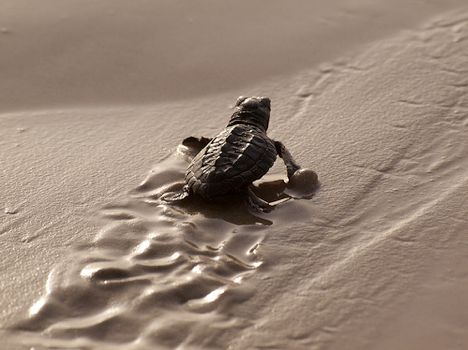Turtle Migration
Biology 342 Fall 2011
Hannah Schaupp, Shelly Skolfield, and Michaela Voorhees
Ontogeny
Hatchlings
Sea turtles have two systems of orientation, oceanic and offshore. It seems that both systems of orientation work properly as soon as a sea turtle hatches. Rather than having an inherent preference to go directions that lead offshore, young turtles rely on cues to direct them out to sea. [8]
After hatching young turtles start crawling immediately toward a source of light, which is hopefully the rising sun and not a resort. After reaching the water they use a combination of light stimulus and wave direction to orient away from shore. Since waves refract as they hit the beach, wave direction close to shore is a reliable indication of direction. Once the hatchlings reach the open ocean, wave direction is no longer informational and the turtles begin orienting using the earth’s magnetic fields.[8]

Figure 1. Hatchling turtle moving toward ocean upon hatching from nps.
The Lohmann laboratory, a leader in Loggerhead hatchling turtle navigation research conducted experiments to determine if hatchlings could use cues such as wave direction or light to set a course offshore using their magnetic compass. They could then continue on this offshore course after for example, wave direction is no longer an accurate indicator of direction.[8]
They tested the effect of wave direction and light stimulus on the magnetic navigation of newly hatched turtles as they travel out to sea.
To test the effect of wave direction they created two groups of Loggerhead turtle hatchlings. Both groups were kept in the dark for the duration of the experiment. One group was put in the experimental pool (similar to one shown on Mechanism page) with waves in a constant direction for fifteen minutes and the other group was given wave stimuli for thirty minutes. After the waves had stopped turtles given thirty minutes with waves were able to maintain the same orientation. If the magnetic field was reversed they reversed their orientation along with it. The 15 minute group was not able to maintain orientation after the cessation of wave stimuli. [8]
To test the effect of light, the lab again created two groups of Loggerhead hatchlings. One group was put in a pool with light from the east, and when this light was turned off they continued to orient east. The second group was placed in a pool with light from the west and when this light was turned off they continued to orient west. They also performed the same tests in arenas where the turtles were allowed to crawl. The Lohmann lab found that both wave direction and light stimulus are used by the turtle hatchlings to associate the magnetic fields with the direction they need to travel, offshore. These results support the hypothesis that hatchling turtles do not have an inherent preference to move in directions that lead offshore, they are lead in that direction by external cues.[8]
Juveniles and Adults
Less is know about the navigation of adult and juvenile sea turtles because their large size makes research difficult. An adult loggerhead sea turtle can weigh up to 100 kg! It is known that, like hatchlings, adults sea turtles use the Earth’s magnetic fields to navigate. A little more is know about juvenile sea turtles. It has been shown that juvenile green sea turtles have a magnetic positioning system, a “magnetic map” of sorts.[9]